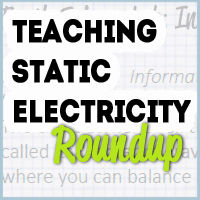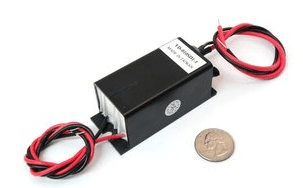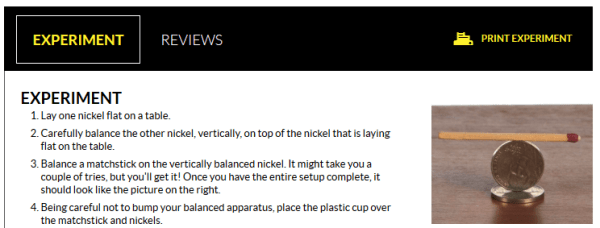Static Electricity Science Lesson Round-up
This is my cheesy advertisement for this post:
Need to add more spark into your static electricity lesson or unit? All of the following ideas are related to static electricity – pick and chose as needed to electrify your teaching.
I was beginning my unit on Electrostatics and I wanted some new ideas. Of course I pinned ideas I found, but I need a dialogue (even if it is with myself in a post) to remember connections. Some of these ideas I already do, some I plan on doing next time, and some I thought I’d share because you might want to do them.
 I like to introduce the unit with this gif. Students get excited about the unit and wonder why this is happening to the cat.
I like to introduce the unit with this gif. Students get excited about the unit and wonder why this is happening to the cat.  Students can uncover the “why” by doing the following demo. I’ve done this with students and I’m always surprised at how amazed they are by this experiment. I’ve also just showed the video and as you could imagine, it doesn’t have the same “wow” factor.
Students can uncover the “why” by doing the following demo. I’ve done this with students and I’m always surprised at how amazed they are by this experiment. I’ve also just showed the video and as you could imagine, it doesn’t have the same “wow” factor.
Moving up from just the traditional rubbing a balloon experiment, students can explore this experiment virtually at PhET. They can even harness the power of static electricity to move a can or Rice Krispies. A charged balloon can easily move tissue paper in the shape of ghosts, bats, snakes, frogs, butterflies flapping their wings, or whatever creative idea you dream up. If you come up with a neat idea, definitely share! With a simple twist, any of these can become a game.
Don’t have balloons? I love the simplicity of this idea from Mama Smiles: packaged air from shipping boxes easily sticks to walls when charged.
Steve Spangler Science has two great experiments using static electricity to move items – one to cause a bag to fly and one to spin a matchstick. If you don’t have matchsticks, there is a variation of this activity that uses Popsicle sticks and spoons. A different version of the flying bag activity uses a pvc pipe instead of a balloon and tinsel (mylar) instead of a plastic bag. I’ve done this version and I learned the hard way that not all tinsel is created equally. Basically I bought a lot of tinsel and found out it didn’t work very well so I had to go back out and by a different brand of tinsel. Definitely test it out before making an investment.
Learn-Play-Imagine has a simple setup for students to MAKE LIGHTNING! Sticking with the light theme, you can use static electricity to light a florescent light bulb like this version here, or like this more advanced version Steve Spangler did on Ellen. If you are looking for an even easier option, they sell a “Human-Powered Light Bulb” specifically designed to be powered by static electricity. I’ve used these before and they do work, but it needs to be dark in order to see the dim light that they produce.
Want to add a challenge element? Students can be challenged to separate salt and pepper.
The Chemical Educational Foundation has a great set of resources called “You be the Chemist”, including a salt and pepper lab.
I’m lucky to have a Van de Graaff generator, but if I didn’t, I’d use the plans from Make Magazine to make one myself. A simpler DIY project is to have students make an electroscope. I’ve done this myself and with students and it can be a hit or miss activity because it has to be well constructed in order to work.
Something I seriously want to build is using this negative ion generator so I can “cast lightning from my fingertips“. This would be one of the craziest demos I do, which is why I want to do it. If you’ve done this, I want to hear about it!
 After investigating electrostatics, my students next move into to current electricity.
After investigating electrostatics, my students next move into to current electricity.
Which idea is your favorite? Do you have a must-do idea that I left out?

P.S. Have you seen static dog?


Leave a Reply